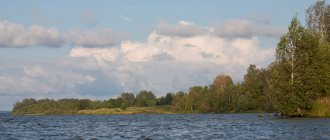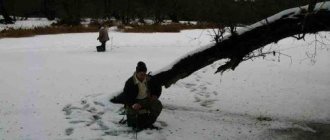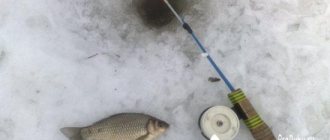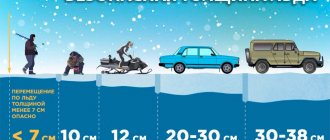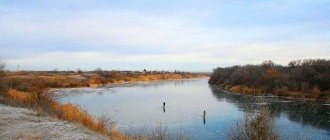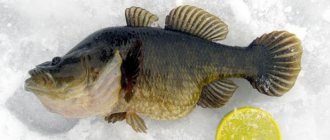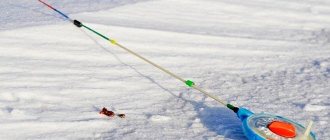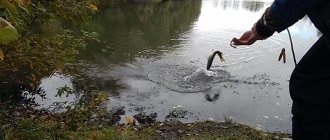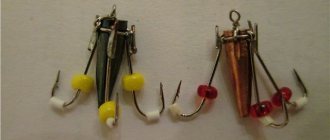Team Nomads
Shchuchye is a lake in the Tver and Smolensk regions of Russia (in the Zharkovsky district of Tverskaya and Demidovsky district of Smolensk).
Belongs to the Western Dvina basin. The area of Lake Shchuchye is 10.8 km², length 14 km, width up to 2 km.
The height above sea level is 177 meters, depth is up to 12 meters. The drainage basin area is 310 km².
HOLY SPRINGS OF THE TVER REGION - HERE!
ATTRACTIONS OF THE TVER REGION - HERE!
GEOGRAPHY OF THE TVER REGION - HERE!
LAKES OF THE TVER REGION - HERE!
TREASURES OF THE TVER REGION - HERE!
ANOMAL AREAS OF THE TVER REGION - HERE!
NATURAL MONUMENTS OF THE TVER REGION - HERE!
Where is it located, how to get there: Lake Shchuchye is located 15 kilometers southwest of the village of Zharkovsky, the southwestern part of the lake runs along the border of the Smolensk region. The lake is strongly elongated from west to east. The shores are slightly indented, swampy in places, dry in others. There are several villages and agricultural lands on the banks, and areas of forest on the southern shore. Several streams and the rivers Gnilitsa, Sinyavka, and Aplava flow into the lake. The Dolzhitsa River flows from the western part of the lake and flows into the Elsha (a tributary of Mezha). Part of the lake (1.8 km²) in the Smolensk region is part of the Smolensk Poozerye National Park . VILLAGE ZHARKOVSKY Zharkovsky is an urban-type settlement, the administrative center of the Zharkovsky district of the Tver region of Russia. Located on the Mezha River ( a tributary of the Western Dvina ), 324 km southwest of the regional center. Founded as the village of Zharki in the 1920s on the site of the villages of Zharki, Borki and Volnushki in connection with the development of the timber industry. Industrial development began with the opening of the railway in the 1930s. The status of an urban-type village has been since 1950. The Zharkovsky railway station is located in the village, the terminus on a branch from the Zemtsy station on the Moscow-Riga line (suburban service is carried out twice a week in 2014, although back in 1982 a passenger train ran twice a day) .
In addition, there is a daily bus service with the Western Dvina, Tver and Smolensk. The extension of the branch towards Smolensk is only available for 4 kilometers, to the village of Krivaya, and has not been used since 2013. Further towards Smolensk the railway has not been used since 1995 and was dismantled by 2004. Wood processing plant (city-forming enterprise: more than a quarter of the working population works), timber industry enterprise, forestry enterprise, dairy plant (as of 2010, it was not operational). By Order of the Government of the Russian Federation dated July 29, 2014 No. 1398-r “On approval of the list of single-industry towns,” the town is included in the category “Single-industry municipalities of the Russian Federation (monotowns) with the most difficult socio-economic situation.”
FISHING ON LAKE SHCHUCHYE The picturesque Lake Shchuchye is located on the territory of the Smolensk and Tver regions. Fishing in the Smolensk region in Lake Shchuchye attracts with the variety and abundance of fish. The area of the lake is 1185 hectares. Part of the lake, namely its Western reach, is part of the Smolensk Poozerie National Natural Park . From the Smolensk region, the lake can be reached by driving through the town of Dukhovshchina towards the village of Ozerny, and from the village to the village of Gorovatka. From the Tver region you need to get through the Western Dvina , from there to the village of Zharkovsky and further to the village of Shchuchye.
On average, the depth of Lake Shchuchye is about 5 m, and maximum depths can reach 12 m. This lake is of glacial origin and is of a hollow type. The location of the lake is hilly-ridge Valdai relief. The lake has a flowing nature and is located in the river basin. Western Dvina. The Dolzhitsa River, which flows into the Elsha River, has its origins in the lake. The bottom, as well as the shores of the lake, are mostly sandy. There are many reed thickets along the banks. There are not many convenient approaches to the shore for personal transport. Fishing in the Smolensk region in Lake Shchuchye mainly occurs for such types of fish as bream, pike, crucian carp, burbot, perch, pike perch, roach, bleak. Other types of fish also live there. Now let's talk about the most promising places for fishing in Lake Shchuchye. Bukhanovo. Behind the village of Bukhanovo the reservoir immediately begins. There is a small sandy beach, to which there is access for vehicles. Near the beach, the bottom of the lake is almost flat, but the closer you get to the middle, the more it drops to the opposite shore, where the channel runs. In the spring, on the right and left sides of this beach, catching large rudd in Lake Shchuchye, weighing up to 1 kg, is very successful. It is best to catch this fish in a wade. Rudds are caught mainly using earthworms or dough flavored with sunflower oil. In the early summer morning, on a sandy beach, you can catch perch using a small spinner, and sometimes you can catch medium-sized and small-sized pike perch. In the daytime, bream can be caught well from a boat on the water. It is usually caught with a winter fishing rod, which is equipped with a strong fishing line with a cross-section of at least 0.25 mm, as well as a hook and sinker. In summer, deep bream resists more stubbornly than in winter, so a strong fishing line definitely won’t hurt here. Several large maggots or a bunch of dung worms are used as bait. It is also possible to catch bream at night on Lake Shchuchye using a donka with a rubber shock absorber. Places are chosen where there are sandy beaches or wide passages in the reeds without dense herbaceous vegetation. Village Cheretnoye
From the village of Bukhonovo further along the lake there is an impassable forest. Before the village of Cheretnoye, the road after the bridge makes a sharp turn. At the turn the view of the lake opens up. In the summer there is a turnoff to the lake. In winter, lines of cars stretch along the road. One winter day I counted up to a hundred cars huddled to the side of the road. The lake begins with a grassy irrigation area. This place is the widest part of the lake. The riverbed runs closer to the opposite bank. In winter you have to tramp through the virgin snow to the other side, where bream is caught better. But when watering, small jigs such as “drop”, “pellet”, “ovinka” are used to catch roach very well. Here they catch large perch using a small spoon of the “bug” or “clove” type.
Closer to the riverbed, when the depth begins to increase rapidly, it is worth trying your luck in catching a spotted predator. Pike bite well during prolonged thaws. Roach, perch, and ruffe act as live bait. She does not disdain the crucian carp she brought with her. Live bait should be lowered into half-water or sometimes only one to one and a half meters down from the ice edge, otherwise you won’t see a bite. The local pike attacks sharply and immediately unwinds all the tackle. If you don’t have time to reach the flag, you can say goodbye to the tackle and the trophy. For some reason, the villagers catch pike near the reeds along the shore with depths of up to one meter. They ignore deeper places and the middle of the lake. As a tackle, villagers use a slingshot in the form of a piece of hose with a wound nylon thread. The slingshot is lowered into the hole, placing a stick across it, on which a loop is put. The gear is checked once a day: in the morning or in the evening. They prefer to catch roach on the same baited holes throughout the winter. If they go out for bream on the old holes left by visitors, then only a few.
Bream can be caught throughout the day, but at night larger specimens are caught. The fishing hole must be immediately made wider than later broken down when catching large fish. To do this, use ice drills with a large auger diameter or drill two holes together and break the partition with an ice pick. To successfully catch bream, you need to feed several holes at a considerable distance from each other and away from your neighbors, so as not to spoil the fishing for yourself or them. The bream is fed with boiled and crushed peas: the yellower the kernels, the more intense the bite. A small lump of bait is thrown into the hole, and when feeding from above, a pinch of the mixture is kneaded in the water with your fingers to create a turbidity. Further supplementary feeding is carried out in small portions or only with the help of dregs. Bream can be caught using both the “Uralka” and the “drop” and “devil”. It is important that the jig be of an acceptable size and that you choose an attractive game to go with it. Many anglers successfully fish with a hook and a sinker. In both cases, the attachment is a bunch of bloodworms.
In summer, pike and perch are caught on spinning baits in clear water overgrown with grass. At this time, a shallow wobbler or light and bulky jig baits work well. Often, perch react positively to spinners. In calm weather, fishing is done on top with a popper. On Lake Shchuchye in early spring, when young reed shoots are just beginning to emerge, the predator is caught on top of the shoots using rotating and lightly oscillating spoons. Mepps Aglia Long 1+ with a copper petal and Mosca Longet No. 2 with various points on the petal proved to be the best at this time. When fishing for large pikes, it is necessary to raise the spinning rod high to prevent the predator from going down into the grass.
In the village itself, access to the lake is possible only in the summer, and then by SUV. But there is an opportunity to leave the car with someone in the village under supervision. Also, at any time of the year, for a reasonable fee, you will be happy to stay overnight, and in the summer you can arrange to rent a wooden boat.
The village of Shchuchye Shchuchye is a fairly large village, there is an entrance to the lake near a small church. The depths begin near the shore. The fishing here is good for roach in deeper places with decent underbreeding. Winter fishing for perch in Lake Shchuchye often pleases anglers with decent catches. They catch striped along the reeds on the opposite side of the lake on the dump. There are also some subtleties here. In winter, perch can be caught well either with a fairly large balancer or with a small, no-attachment tungsten jig. Here, along the reeds, almost near the shore, they set up girders for pike perch and pike perch. Fishing for pike perch in Lake Shchuchye can also be very successful. To be sure to catch a fanged one, you should find a “can” in the middle of the lake, where sharp depths border it. The best way to catch pike perch is by vertical trolling. In this case, the spoon is smoothly lifted up and then sharply thrown to the bottom. The village of Morozovo Beyond the village of Shchuchye, an asphalt road stretches to the village of Zharkovsky, and we turn left onto a dirt road. The silo located on the right next to the road will serve as a guide to the correct path. The road takes us to the village of Morozovo and to the shore of the lake. You can drive further either in dry weather or by SUV, and even then it’s not far. At this point, a small river flows into the reservoir, where roach and bream enter in the spring and are successfully caught using float gear. It is advisable to immediately collect caddis flies in the river, as this is the most optimal bait for river fishing. If you don’t find a caddisfly, stock up on small dung worms or maggots in advance. No bait is required on the river; select a pool and move the stick with the flow. In spring, roaches gravitate towards last year's vegetation. As the water warms, a large amount of zooplankton develops during decay, which serves as food for fish.
Beyond the village of Morozovo, the lake makes a sharp turn to the south. Around the bend there is a small island closer to the opposite shore. The area along the island is completely overgrown. Here is the kingdom of pike, perch, large rudd, crucian carp and tench. Rudd can be caught by moving a boat and throwing the bait into small windows of clear water. The rudd bites sharply, and the float quickly moves to the edge of the window. If there are no bites, move to the next window. The main thing in this fishing is to be extremely careful and not make noise. Rudd are caught from the surface. As a tackle, you can use a rig with a transparent round float without a sinker. The fish prefer a slow-moving bait. Crucian carp and tench should be stimulated by feeding them for a long time in the same place. Only such tactics can bear abundant fruit. The tackle has to be very light and lightly loaded. I prefer fishing with maggots, as the fish grab them without any whims. Komorovo village
We explored the northern side of the lake as far as possible and as far as I could go myself. Now it's worth walking along the south side. From Horovatka there is a dirt road away from the lake. Before the Velistitsa River, the road to Komorovo turns off the dirt road. You can drive along it only in dry weather or with an SUV. You reach the lake itself to the shore. There is a fork near the shore: to the right - to the village; to the left - you can drive almost to the river’s confluence with the lake. Towards the river there is a shore on the lake with the possible establishment of a tent camp. The depth gradually decreases. There are many fairly wide, clear passages in the reeds. Just before the river there is a cape that juts far into the lake. From this cape, locals prefer to catch bream using elastic bands. Along the entire shore behind the reeds there are a lot of perch, which can be caught well with spinners. The bait should be cast at a fast pace so as not to get caught in the underwater vegetation that is found in places along the shore. You can take a boat from the side of the lake into the river; it is quite wide when approaching the lake. It is necessary to choose places where the river reaches end in a slight narrowing. As a rule, reeds grow along the banks of these narrowings. We position the boat on one side of the narrowing and cast the float to the other side, right up to the wall of the reeds. When swimming bait, be it maggot or worm, quite large roach, rudd and perch bite. Once, my wife and I got carried away with such fishing, we caught a full cage of fish, which I then barely lifted into the boat. Opposite the river in winter, closer to the middle of the lake, bream bites well, but, unfortunately, at this time there is no road on this side, and you have to come here from the other bank.
Near the village of Komorovo, not far from the shore, there is a riverbed. The depth begins with a sharp drop. The banks are steep. The coastal part is strewn with cobblestones that go into the water. In the morning and evening dawns, pike perch rises here from the depths to hunt, preferring floating wobblers with a diving depth of 1.5-2 meters. During the day, perch live among the rocks. There are few pike. They approach this shore only in winter. We often go here in winter for bream. You can leave the car on the opposite side, behind the village of Bukhonovo on the road, it’s closer than going from Cheretny to the river, and the bream bites the same way. When going to the opposite bank, it is worth taking care of the safety of the vehicle. Lately, cases of local motorcyclists draining fuel from gas tanks have become more frequent, so locking traffic jams is a good idea. It is advisable to equip the wheels with anti-theft nuts, and in the cabin you should not leave things that could provoke burglary, such as a radio, sunglasses, or new clothes. Bream from the Komorovskaya side bite mainly closer to watering. There are days when only one roach is caught from the depths, this is especially true during a thaw with rain. During the thaw, you need to take care of dry feet, since there is always water on the ice here and there is quite a lot of it.
In summer and spring, it is worth paying attention to the Velestitsa River, where the road from Horovatka passes through a bridge. On the right side of the bridge there are small pools where roach, bleak and silver bream are caught in the spring. In summer, among the thickets of grass, you can catch large perch, tench and bream with a fishing rod. I would advise wandering along the river with a telescopic fishing rod equipped with a side nod and a jig. Firstly, it is more convenient to lower the jig into gaps in the grass, sometimes not larger than a five-ruble coin. Secondly, you can fish from the edge of the grass, carefully lowering the jig a few centimeters under the water. Often large fish stand right under the leaf, where various insects stick to the underside. Thus, tench is often caught. If you are not addicted to jig summer gear, use a jig instead of a hook, and the number of large fish in your catch will increase.
Behind the bridge over Velestitsa there is a right turn to the village of Berkovo. From the village you can reach the lake itself by car. A sandy beach will open before your eyes. This coast juts out into the land with a decent bay. In the middle of the bay, bream and large roach are caught from boats using side rods. But unlike other places, bream does not immediately respond to bait. You will have to feed the place for a day or two in order to fish fruitfully later. Pike perch often enters the bay in the evening. Here it is preferable to catch it near the bottom with jig baits or deep-diving wobblers. On the sandy beach, fishing at night with an elastic band is possible, since the entire area from the shore is free of underwater vegetation.
In winter, more hardy fishermen come to this side for bream from Cheretny and often leave with large catches. But before you decide on such a hike, calculate your strength. Walking on deep virgin snow is very difficult, especially if there is slippery smooth ice under your feet.
PARK SMOLENSKOYE POOZERIE
Smolensk Poozerie is a national park in the European part of Russia, in the northwestern part of the Smolensk region, in the Dukhovshchinsky and Demidovsky districts. It has the status of a biosphere reserve.
The national park is under the jurisdiction of the Ministry of Natural Resources and Ecology of the Russian Federation.
The Smolensk Poozerie National Park was created on April 15, 1992.
The creation of the park pursued the goals of preserving unique virgin broad-leaved and dark coniferous forests, studying the flora and fauna of the region, and ensuring the use of renewable natural resources for environmental protection and recreational purposes.
The shape of the park's territory resembles a rhombus with diagonals of 50 km from north to south and 55 km from west to east. The park owes its name to a large number of lakes.
In 1993, the scientific and technical council of the park was created.
In 1995, the park took an active part in the international “March of Parks” campaign and became one of its winners.
In 1998, the park was accepted into the Federation of Natural and National Parks of Europe "Europark" (English)Russian..
In 2002, the national park was accepted into the biosphere reserves of the UNESCO Man and the Biosphere program.
Until 2000, the administration of the national park was located in the village of Podosinki. By the new millennium, the village of Przhevalskoye became the “capital” of the national park.
Now the national park offers a number of tourist routes in the vicinity of the village of Przhevalskoye, hosts cultural events (March of Parks, bard song festivals, etc.), and also participates in environmental education for schoolchildren. The activities of the park greatly increase the interest of tourists in this region. On the southwestern shore of Lake Sapsho there is an observation deck and tourist sites. Children's and youth camps are often located there.
There are 77 archaeological sites in the park. Among them are the children of the ancient Russian city of Verzhavsk, Stone Age sites, settlements, settlements, settlements, and burial grounds. The archaeological complex of the ancient Russian city of Verzhavsk and the burial mound (31 mounds) of the 8th-13th centuries near the village of Anosinki have the status of monuments of federal significance[6]. There are 93 historical monuments: memorial complexes, memorial sites (including preserved military fortifications, battle sites, burial places related to the events of the Great Patriotic War), architectural monuments.
Museums are open: the house-museum of the traveler N. M. Przhevalsky and the Museum of Partisan Glory (in the village of Przhevalskoye), a private museum of birch bark in the village of Anosinki, a private museum-vernissage “Alone with a Tree” in the village of Boroviki. There are two churches - in the village of Przhevalskoye (built in 1782) and in the village of Baklanovo. Several dilapidated temples and 4 holy springs with baths have been preserved. From the peasant farm in the village of Shugailovo to the village of Sokorevo, where the holy spring of Paraskeva Pyatnitsa is located, there is an ecological trail “Legends of Deep Antiquity”, the key core of which is the history and artistic reconstruction of a number of objects - watchtowers, a temple with a wooden idol on the territory of the ancient settlement .
Where is? How to get there?
You can get to the National Park by train from the Moscow Belorussky Station to Smolensk Station, or by bus from the square at the Belorussky Station in Moscow to Smolensk. From Smolensk, take a regular bus to Demidov, where you change to a bus going to the village of Podosinki and passing through Baklanovo.
If you are traveling by car from Moscow, then take the Moscow-Minsk highway, passing Smolensk, to the village of Olsha. Then turn right and follow the Velizh-Nevel highway until the turn at kilometer 57, where you turn right to the village of Przhevalskoye (near the village of Lobanovo). Then go straight to the sign for the villages of Zaborye and Baklanovo. Drive another 17 kilometers and you are there.
_____________________________________________________________________________________________________________________ SOURCE OF MATERIAL AND PHOTO: Team Nomads Encyclopedic reference book “Tver region” Shchuchye, lake // Encyclopedic Dictionary of Brockhaus and Efron: in 86 volumes (82 volumes and 4 additional). - St. Petersburg, 1890-1907. Encyclopedia of the Smolensk region. Lakes of the Tver region.
| The attachment | Size |
| 72.94 KB | |
| 33 KB |
Fishing on Lake Shchuchye in the Smolensk region
The picturesque Lake Shchuchye is located on the territory of the Smolensk and Tver regions. Fishing in the Smolensk region in Lake Shchuchye
attracts with the variety and abundance of fish.
The area of the lake is 1185 hectares. Part of the lake, namely its Western reach, is part of the Smolensk Poozerie National Natural Park. From the Smolensk region, the lake can be reached by driving through the town of Dukhovshchina towards the village of Ozerny, and from the village to the village of Gorovatka. From the Tver region you need to get through the Western Dvina, from there to the village of Zharkovsky and further to the village of Shchuchye. On average, the depth of Lake Shchuchye is about 5 m, and maximum depths can reach 12 m. This lake is of glacial origin and is of a hollow type.
The location of the lake is hilly-ridge Valdai relief. The lake has a flowing nature and is located in the river basin. Western Dvina. The Dolzhitsa River, which flows into the Elsha River, has its origins in the lake. The bottom, as well as the shores of the lake, are mostly sandy. There are many reed thickets along the banks. There are not many convenient approaches to the shore for personal transport. Fishing in the Smolensk region in Lake Shchuchye
mainly occurs on such types of fish as bream, pike, crucian carp, burbot, perch, pike perch, roach, bleak. Other types of fish also live there.
Now let's talk about the most promising places for fishing in Lake Shchuchye.
Bukhanovo.
Behind the village of Bukhanovo the reservoir immediately begins. There is a small sandy beach, to which there is access for vehicles. Near the beach, the bottom of the lake is almost flat, but the closer you get to the middle, the more it drops to the opposite shore, where the channel runs.
In the spring, on the right and left sides of this beach, fishing for large rudd in Lake Shchuchye
, weighing up to 1 kg. It is best to catch this fish in a wade. Rudds are caught mainly using earthworms or dough flavored with sunflower oil.
In the early summer morning, on a sandy beach, you can catch perch using a small spinner, and sometimes you can catch medium-sized and small-sized pike perch. In the daytime, bream can be caught well from a boat on the water. It is usually caught with a winter fishing rod, which is equipped with a strong fishing line with a cross-section of at least 0.25 mm, as well as a hook and sinker. In summer, deep bream resists more stubbornly than in winter, so a strong fishing line definitely won’t hurt here. Several large maggots or a bunch of dung worms are used as bait.
Night fishing for bream on Lake Shchuchye is also possible using a donka with a rubber shock absorber.
. Places are chosen where there are sandy beaches or wide passages in the reeds without dense herbaceous vegetation.
Village Chertnoye
The road near the bridge in front of the village of Chertnoye makes a rather sharp turn. And around the bend Lake Shchuchye begins. In the summer, there is a ramp to the lake near the turnoff. And in winter, fishermen leave their cars along the road. The lake begins with irrigation, overgrown with grass. This is where the widest part of the reservoir is located. The riverbed is located close to the opposite bank. In winter, you should follow the bream to the opposite bank; usually the bream bite is more active there. And during the watering season, winter roach fishing in Lake Shchuchye
will delight fishermen with excellent catches. It is best to catch roach using oatmeal, shot or drop. Also here, large-sized perch are caught using small lures such as “cloves” or “beetles”. Closer to the riverbed, the depth begins to increase sharply and here there is a chance to catch a pike. Spotted predators are caught especially well here during long thaw periods. They use roach, perch, ruffe, and less often crucian carp as live bait. It is recommended to let live bait into the water. The lake pike here likes to attack sharply and almost immediately unwinds almost all the tackle. Local village fishermen usually hunt for pike near reeds, and catch them at a depth of no more than 1 meter. But they don’t pay attention to the deeper places located in the middle of the lake. Local fishermen catch roach on baited holes, using the same ones all winter. Only a few go out for bream.
Ice fishing for bream on Lake Shchuchye
lasts all day long, but at night larger individuals are encountered. Therefore, at night the holes are made wider so as not to widen it at the time of landing the fish.
In the summer, in watering areas overgrown with grass, in algae-free windows, perch and pike are caught using spinning baits. Wobblers with a small depth work well at this time, as well as voluminous and light jig baits. Perch is also excellently caught on spinners. If you approach the lake from the village, this can only be done in the summer and then in an SUV. Therefore, it is better to negotiate with one of the local residents and leave the car with them. In addition, for a small fee you can stay overnight and also rent a wooden boat for fishing.
Shchuchye village
Shchuchye, a fairly large village, there is an entrance to the lake near a small church. The depths begin near the shore. The fishing here is good for roach in deeper places with decent underbreeding.
Winter fishing for perch in Lake Shchuchye
often pleases fishermen with decent catches. They catch striped along the reeds on the opposite side of the lake on the dump. There are also some subtleties here. In winter, perch can be caught well either with a fairly large balancer or with a small, no-attachment tungsten jig.
Here, along the reeds, almost near the shore, they set up girders for pike perch and pike perch. Fishing for pike perch in Lake Shchuchye
, can also be very successful. To be sure to catch a fanged one, you should find a “can” in the middle of the lake, where sharp depths border it. The best way to catch pike perch is by vertical trolling. In this case, the spoon is smoothly lifted up and then sharply thrown to the bottom.
Village Morozovo
Another excellent place for fishing on Lake Shchuchye is located in the vicinity of the village of Morozovo. To get to Morozovo, you should take the asphalt highway, which stretches beyond the village of Shchuchye, to the village of Zharkovsky. From the highway you should turn left onto the dirt road. This road goes to the village of Morozovo and further to Lake Shchuchye.
Here a small river flows into the lake, into which a lot of bream and roach enter in the spring. At this time, white fish can be successfully caught here using float tackle. At this time, there are a lot of caddis flies in the river, which are excellent baits.
Beyond Morozovo, the reservoir turns sharply to the south. And around the bend there is a small island. Near the island the space is heavily overgrown with grass. However, a wide variety of fish are excellently caught here. Large rudd, tench, crucian carp, pike and perch are caught here.
Fishing for rudd in Lake Shchuchye,
occurs from a boat, in the windows of clear water. If no bites occur in one window within 5 minutes, move to the next window. You can catch tench and crucian carp using the same method.
Happy fishing!
